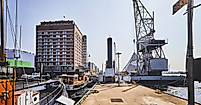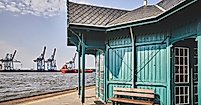
On 22 November 2024, the new visitor and information centre of the Oevelgönne Museum Harbour will be officially opened. Built on a historic floating pontoon, it not only offers exciting insights into Hamburg's maritime history, but also a panoramic view of the harbour and its treasures.
Inauguration of the new floating visitor and information centre in Museumshafen Oevelgönne
After around nine months of construction, the Museumshafen Oevelgönne is about to celebrate a significant event: the inauguration of the new visitor and information centre. This modern building, which was constructed on a historic floating pontoon, is based on the tradition of the so-called harbour berths - floating buildings that were previously used as workshops or warehouses.
In future, the centre will serve as a contact point for visitors to the museum harbour and provide information about the historic ships moored there and the work of the association. It will also be used for events, training courses and guided tours. With its 150 square metres of space, it offers a unique view of both the port's historic ships and the lively backdrop of Hamburg's container port.
With the new building, the museum harbour underlines its importance as part of Hamburg's maritime cultural landscape and at the same time creates a platform that makes the commitment to the preservation of historic ships visible. The project was financed by funding from the City of Hamburg, the federal government and private donations.
Experience historic ships at first hand
Five of the ships are owned by the association Museumshafen Oevelgönne e. V., which operates this port, others belong to the Altonaer Museum, the Museum für Hamburger Geschichte, the Museum der Arbeit or are privately owned.
Visitors can stroll along the jetties and read the information boards about the ships, but some ships also offer guided tours. There are no special times for sightseeing, but most crews are happy to receive visitors. Donations for the preservation are gladly taken. On the D.E.S. Bergedorf is the Museumshafen Café, where typical Hanseatic cuisine is served.
Those who have marvelled at enough pots should relax at Hamburg's Elbe beach. Right next to the harbour are the small, colourful little houses where sailors used to live, and next to them stretches the Elbe beach. In summer, sun-hungry locals and guests alike come here, and you could almost think you are on the Mediterranean and not in Hamburg in northern Germany. A coffee or an ice cream in one of the beach cafés, and the holiday feeling is perfect. The most famous café on Hamburg's city beach is the Beach Pearl.
Old Swede! A foundling is the first immigrant of the Hanseatic city
If you stroll along the Elbe beach, you will come to Old Sweden, a huge boulder discovered during excavation work. The over 1.7 million year old stone with a weight of 217 tons probably came here from Sweden in one of the ice ages, hence the name. One is always surprised, if one lies the monster from another time so there.


















